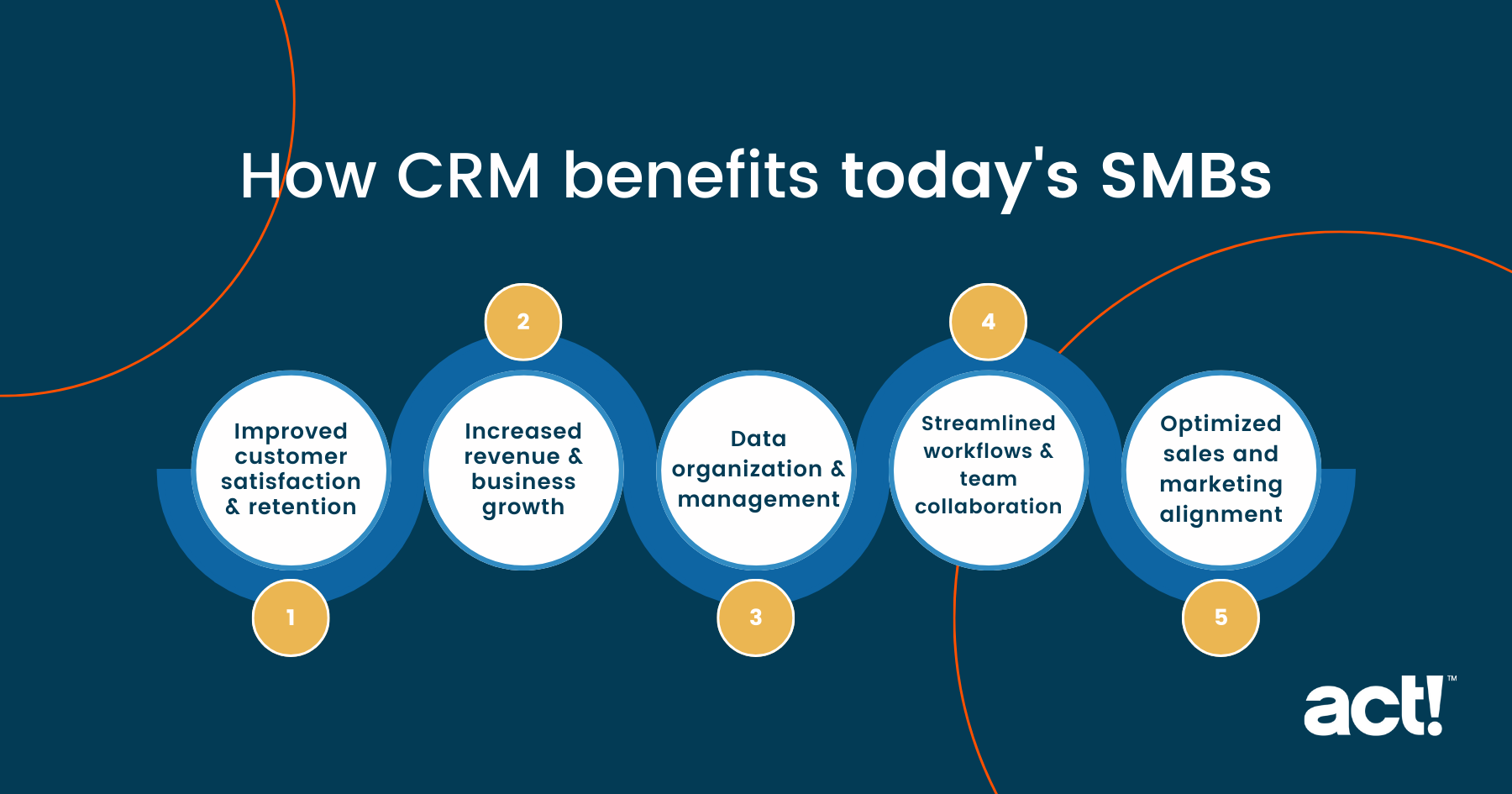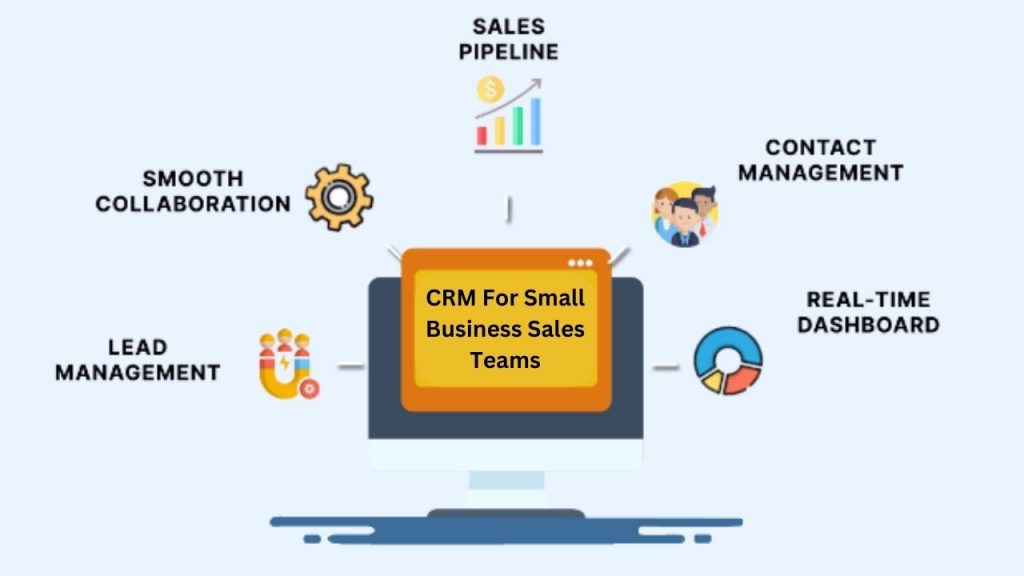CRM systems enhance team collaboration. They help small and medium-sized businesses (SMBs) thrive.
Team collaboration is vital for SMBs. Efficient communication and streamlined processes can significantly impact growth. CRM systems designed for team collaboration offer unique benefits. These tools enable better task management and improved customer interactions. They ensure that all team members stay on the same page.
This leads to increased productivity and higher customer satisfaction. In this blog post, we will explore CRM systems focused on team collaboration. We’ll discuss their features and how they can benefit SMBs. Whether you are a small business owner or a team leader, understanding these tools can transform your workflow. Join us as we dive into the world of collaborative CRM systems for SMBs.

Credit: www.act.com
Introduction To Crms For Smbs
Small and medium-sized businesses (SMBs) need efficient systems to stay competitive. One such system is Customer Relationship Management (CRM) software. CRM software helps manage customer interactions and data. It also aids in team collaboration, especially for SMBs. This blog will explore how CRMs focused on team collaboration can benefit SMBs.
Importance Of Team Collaboration
Team collaboration ensures everyone is on the same page. Effective communication within a team boosts morale. It helps resolve issues faster. Shared goals drive better results. CRMs enable this by centralizing information. All team members can access customer data in real-time. This reduces misunderstandings and improves service quality.
Boosting Productivity
Productivity is crucial for SMBs. CRMs save time by automating tasks. This frees up employees for more important work. It also reduces errors. Automated reminders ensure no task is forgotten. Teams can track progress easily. Collaboration features like shared calendars and task lists keep everyone organized. The result? Higher productivity and better customer service.
Key Features Of Collaborative Crms
Collaborative CRMs are essential for small and medium businesses (SMBs). They enhance team collaboration and streamline processes. Below are the key features that make these CRMs indispensable for SMBs.
Want to know more about CRM and Customer Support? Check out this article for helpful insights. Saas CRMs for Multilingual Customer Support: Boost Global Engagement
Real-time Communication
Real-time communication is vital for team collaboration. Collaborative CRMs offer tools that enable instant messaging, video calls, and chat functionalities. These tools help teams stay connected. They ensure everyone is on the same page and can make quick decisions. This feature enhances productivity and reduces delays.
- Instant Messaging: Quick text-based communication within the team.
- Video Calls: Face-to-face virtual meetings for better interaction.
- Chat Rooms: Group discussions for team projects and updates.
Task Management Tools
Task management tools are crucial for organizing work. These tools help in assigning tasks, setting deadlines, and tracking progress. Collaborative CRMs integrate these tools to improve efficiency. This ensures that every team member knows their responsibilities and timelines.
| Feature | Benefit |
|---|---|
| Task Assignment | Assign tasks to team members with clear instructions. |
| Deadline Setting | Set deadlines to keep projects on track. |
| Progress Tracking | Monitor the status of tasks in real-time. |
These features ensure that projects are completed on time. They also help in identifying any bottlenecks. This makes it easier to manage workloads and resources efficiently.
Collaborative CRMs are a boon for SMBs. They offer tools that enhance team collaboration and improve productivity. By leveraging these features, teams can work more effectively and achieve their goals efficiently.
Benefits For Small And Medium Businesses
Using a CRM focused on team collaboration offers many benefits for small and medium businesses (SMBs). These tools help teams work together better and more efficiently. They also simplify tasks and improve communication. Let’s explore the main benefits:
Enhanced Team Efficiency
CRMs designed for collaboration boost team efficiency. They provide a central place for all team activities. This means team members can easily access needed information. Sharing updates and notes becomes seamless. No more hunting through emails or messages. Everyone stays on the same page.
Tasks get assigned and tracked in one system. This reduces misunderstandings. The team knows what needs doing and by whom. It keeps everyone accountable. As a result, work flows smoothly and productivity increases.
Enhance your knowledge on CRM and Customer Support by exploring this related piece. Why Does Zoho CRM Have List Descending: Top Benefits Explained
Streamlined Processes
CRMs help streamline business processes. They automate routine tasks. This saves time and reduces errors. For example, follow-up emails can be sent automatically. Data entry becomes quicker and more accurate. Automation frees up time for strategic tasks.
These systems also integrate with other tools. This means less switching between apps. Everything needed is in one place. Streamlined processes lead to smoother operations. SMBs can then focus on growth and customer satisfaction.

Credit: orgzit.com
Top Crms For Team Collaboration
Small and medium businesses (SMBs) need effective tools for team collaboration. A Customer Relationship Management (CRM) system can help. These systems keep everyone on the same page. They streamline communication and improve productivity. Let’s dive into some of the top CRMs for team collaboration.
Comparison Of Leading Platforms
Here is a comparison of some leading CRM platforms focused on team collaboration:
| CRM Platform | Key Features | Pros | Cons |
|---|---|---|---|
| HubSpot CRM |
|
|
|
| Zoho CRM |
|
|
|
| Monday.com |
|
|
|
Choosing The Right Crm
Choosing the right CRM can be challenging. Here are some tips to help you decide:
- Assess your needs: Understand what your team requires. Make a list of essential features.
- Set a budget: Know your budget. Compare the pricing of different CRMs.
- Read reviews: Check reviews. Learn from other SMBs’ experiences.
- Try free trials: Use free trials. Test the software before committing.
- Consider scalability: Ensure the CRM can grow with your business.
Choosing the right CRM is crucial for effective team collaboration. Evaluate your options and make an informed decision.
Integrating Crms With Existing Tools
Integrating CRMs with existing tools can transform how small and medium-sized businesses (SMBs) operate. By ensuring your Customer Relationship Management (CRM) software works well with your current tools, you can improve team collaboration and efficiency. Let’s explore how seamless software integration and maximizing tool efficiency can benefit your business.
Discover engaging insights on CRM and Customer Support by reading this featured article. Real-Time Metrics Tracking for E-Commerce CRM Users: Boost Sales Now
Seamless Software Integration
Seamless integration with existing tools is vital for effective CRM use. Many SMBs already use tools like email platforms, project management software, and marketing automation tools. Integrating your CRM with these tools can save time and reduce manual data entry.
Consider the following benefits of seamless integration:
- Centralized Data: All customer information in one place. No need to switch between tools.
- Improved Communication: Teams can access shared data easily, leading to better collaboration.
- Enhanced Productivity: Automate repetitive tasks, freeing up time for strategic work.
Maximizing Tool Efficiency
To maximize tool efficiency, ensure your CRM integrates with your most-used tools. This can include email services, social media platforms, and accounting software.
Here are some ways to maximize efficiency:
- Automated Workflows: Set up workflows to automate tasks, such as sending emails and updating records.
- Real-Time Updates: Keep data current with real-time updates across integrated tools.
- Customizable Dashboards: Create dashboards that show key metrics from different tools in one view.
Here’s a table to illustrate the benefits of integrating different tools with your CRM:
| Tool | Integration Benefit |
|---|---|
| Email Platform | Automated email tracking and customer communication |
| Project Management Software | Streamlined task assignments and progress tracking |
| Marketing Automation Tools | Enhanced campaign management and lead tracking |
By integrating your CRM with existing tools, you can enhance team collaboration and operational efficiency. This can lead to better customer relationships and overall business growth.
Best Practices For Implementation
Implementing a CRM focused on team collaboration can be a game-changer for SMBs. It enhances communication, streamlines processes, and boosts productivity. But, to achieve these benefits, proper implementation is crucial. Here are some best practices to ensure a smooth and successful CRM implementation.
Training Your Team
Training your team is essential for successful CRM implementation. A well-trained team adapts quickly and uses the CRM effectively. Here are some steps to ensure effective training:
- Conduct Training Sessions: Schedule regular training sessions for all team members.
- Provide Resources: Offer manuals, tutorials, and FAQs to help them understand the CRM.
- Hands-On Practice: Allow team members to use the CRM in a controlled environment.
- Ongoing Support: Ensure continuous support and be available for any questions.
Setting Clear Goals
Setting clear goals helps in measuring the success of the CRM implementation. Clear goals also align the team’s efforts and improve focus. Here are some steps to set effective goals:
- Define Objectives: Identify what you want to achieve with the CRM.
- Set Measurable Goals: Ensure goals are specific, measurable, achievable, relevant, and time-bound (SMART).
- Communicate Goals: Share these goals with the entire team.
- Track Progress: Use the CRM to monitor progress and make necessary adjustments.
Following these best practices can lead to a successful CRM implementation. It ensures that the team is well-prepared and aligned with the company’s objectives.
Case Studies Of Successful Smbs
Successful SMBs often use CRMs focused on team collaboration. These systems improve communication and streamline processes, boosting productivity.
Exploring the impact of CRM systems on team collaboration among small and medium-sized businesses (SMBs) can offer valuable insights. Real-world examples show how these systems enhance productivity and streamline operations.Real-world Examples
One small business, a boutique marketing agency, implemented a CRM focused on team collaboration. This agency saw a 30% increase in project completion rates. The CRM allowed team members to assign tasks, track progress, and communicate in real-time. This eliminated the need for lengthy email threads and frequent meetings. Another example is a family-owned retail store. They used a CRM to manage inventory and customer interactions. The CRM helped the team stay updated with stock levels and customer preferences. This led to a 20% increase in customer satisfaction. The team could quickly respond to customer inquiries and ensure timely restocking of popular items.Lessons Learned
From these examples, some key lessons stand out. First, clear communication within the team is crucial. A CRM that supports real-time updates and task assignments can significantly improve efficiency. Second, understanding customer needs can drive business growth. A CRM that tracks customer interactions helps tailor services to meet these needs. Another lesson is the importance of data accessibility. Team members should have easy access to the information they need. This ensures that everyone is on the same page and can make informed decisions. Lastly, integrating a CRM into daily operations requires commitment. Training and regular use are essential to maximize its benefits. These case studies demonstrate how CRM systems focused on team collaboration can transform small and medium-sized businesses. By improving communication, understanding customer needs, and ensuring data accessibility, SMBs can achieve greater success. “`Future Trends In Crm Technology
Future trends in CRM technology are shaping the way small and medium-sized businesses (SMBs) collaborate. These trends focus on improving team collaboration and streamlining operations. Let’s explore some of these trends.
Ai And Automation
Artificial Intelligence (AI) and automation are transforming CRM systems. AI helps in predicting customer behavior. This allows teams to make data-driven decisions. Automation handles repetitive tasks. This frees up time for more critical activities. For example, chatbots can answer common customer questions. This reduces the workload on support teams.
Enhanced User Experience
User experience (UX) is critical in CRM systems. Modern CRMs focus on a clean and intuitive interface. This makes it easier for teams to navigate and use the system. Mobile-friendly designs are also essential. Teams can access CRM data on-the-go. Simplified dashboards provide quick insights. This helps in making informed decisions quickly.

Credit: orgzit.com
Frequently Asked Questions
What Is A Crm For Team Collaboration?
A CRM for team collaboration is a tool designed to help small businesses manage customer relationships and enhance team communication.
How Do Crms Benefit Smbs?
CRMs benefit SMBs by improving customer management, streamlining communication, and boosting team productivity through enhanced collaboration tools.
Can Crms Improve Team Productivity?
Yes, CRMs improve team productivity by centralizing information, automating tasks, and fostering better communication among team members.
Are Crms Cost-effective For Small Businesses?
Yes, CRMs can be cost-effective for small businesses by improving efficiency, reducing manual tasks, and enhancing customer satisfaction.
Conclusion
Choosing the right CRM can boost team collaboration for SMBs. It simplifies communication. It ensures everyone stays on the same page. A good CRM saves time and reduces errors. Teams work better together. Your business can grow smoothly. Invest in a CRM that fits your needs.
It makes a big difference. Consider your options carefully. Your team will thank you.











